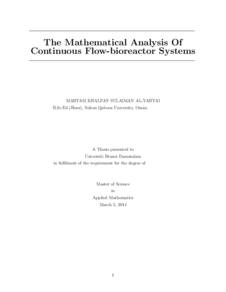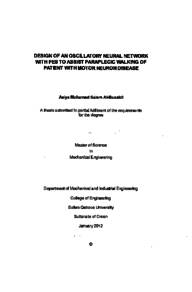Document
The mathematical analysis of continuous flow-bioreactor systems.
Identifier
AL-Yahyaiyah, Maryam Khalfan (2014). The mathematical analysis of continuous flow-bioreactor systems (Master thesis, Universiti Brunei Darussalam, Brunei).
Publisher
Universiti Brunei Darussalam.
Gregorian
2014
Language
English
English abstract
Chapter 1 gives some basic topics related to the field of dynamical systems. Linear and nonlinear dynamical systems in one and two dimensions are discussed. Two types of the steady-state solutions of dynamical systems, fixed points and periodic orbits, and their stabilities are given. The linearisation method is introduced to determine the stability of the fixed points of nonlinear systems. At the end of the chapter an elementary introduction in bifurcation of dynamical systems is discussed.
Chapter 2 give some basic topics and terminologies related to the subject of biochemical engineering which are important to understand the bio-chemical process before analysing its mathematical model. Three types of reactors and their operations are introduced. The continuous flow stirred-tank reactor is taken an example to show the construction of the model equations for a biological process taking place in such reactor and subject to Monod growth equation. Other modifications for the Monod equation are also discussed.
In chapter 3 the steady-state operation of a continuous flow reactor in which a bio- chemical reaction is governed by the Monod growth kinetics subject to competitive substrate inhibition is analysed. The steady-state solutions are found and their stabilities are dis- cussed using residence time as a bifurcation parameter.
In chapter 4 the steady-states of a continuous flow bio-reactor in which micro- organism grow by utilizing a substrate is analyzed. The biochemical reaction is governed by Monod ix growth kinetics subject to non-competitive substrate inhibition. The inhibition scheme considered generalizes the classical Andrews model. The steady-state solutions are found and their stabilities are determined by using the residence time as the bifurcation parameter. The performance of the reactor is described in the limit of small and large values for residence time by finding asymptotic solutions.
Member of
Resource URL
Category
Theses and Dissertations


